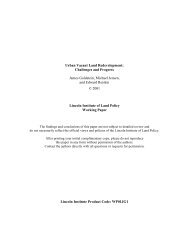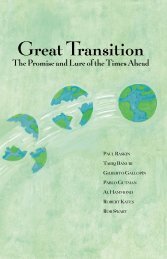training exercises - Tellus Institute
training exercises - Tellus Institute
training exercises - Tellus Institute
Create successful ePaper yourself
Turn your PDF publications into a flip-book with our unique Google optimized e-Paper software.
4.3.7 Resource Costs<br />
Finally, under the Resources section of the tree, you will specify the unit costs for<br />
indigenously produced and imported primary resources and secondary fuels. Use the<br />
following information to enter these costs.<br />
Primary Resources (Indigenous production and imports):<br />
• Coal - $20/tonne in 2000, rising to $30/tonne in 2030<br />
• Natural gas - $0.1/m 3 in 2000, rising to $0.2/m 3 in 2030<br />
• Crude Oil - $30/tonne, rising to $50/tonne in 2030<br />
Secondary Resources:<br />
• Diesel, Gasoline, LPG, kerosene and Fuel Oil - $300/tonne in 2000, rising to<br />
$400/tonne in 2030<br />
• Electricity is not priced here since you are modeling electricity costs instead on<br />
the basis of input fuel and power plant costs.<br />
Enter this base year cost data in the Current Accounts scenario since all of the scenarios<br />
assume the same unit costs. Cost projections can be entered once for the Reference scenario.<br />
4.4 Showing Cost-Benefit Results<br />
In the Manage scenarios screen you can click the check boxes on the tree to indicate which<br />
scenarios should be calculated. To keep the results reasonably simple at first you may want to<br />
check only the Reference and Mitigation Scenarios.<br />
In the Summaries view you can<br />
display the Net Present Value (NPV)<br />
of the mitigation scenario relative to<br />
another selected scenario. The NPV<br />
is the sum of all discounted costs and<br />
benefits in one scenario minus another<br />
(summing across all years of the<br />
study).<br />
You should see results similar to those<br />
shown on the right. Notice that these<br />
indicate that on the demand- side the<br />
Mitigation scenario shows costs more<br />
than the Reference scenario (since<br />
here we are investing capital and<br />
O&M into energy efficiency<br />
measures) but that this is more than<br />
made up for in savings in the<br />
Transformation modules and in<br />
avoided resource requirements, so that<br />
47




